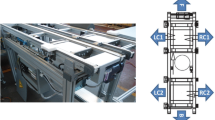This paper describes the results of the DIREK Project (knowledge-based, real-time diagnosis and repair for a robotized handling and storage system), aimed at developing a real-time diagnosis system for a highly automated SNIA fibre spinning plant. The project effectively implemented a multi-model approach to diagnosis in manufacturing environments, exploiting structural, functional, behavioural and heuristic models. Among other things, particular emphasis has been placed on the plant behavioural model, which can be derived from the software code running on the PLCs which control an automated manufacturing facility. The existing diagnostic system is now operational at an SNIA plant in Italy, fully integrated with the factory environment and able to support different levels of users through distributed man-machine interfaces. The paper provides an insight into the theoretical background of the project and describes the adopted methodology, with special attention given to the knowledge acquisition problems arising in the development of the various knowledge models included in the diagnostic system. Furthermore, the architecture and functionalities of the existing system are described, along with the achieved benefits and further exploitation potential. Both IT and user perspectives are considered in the paper.
Similar content being viewed by others
References
Brachman, R. J. (1979) On the epistemological status of semantic networks, in Associative Networks: Representation and Use of Knowledge by Computers, Findler, N. V. (ed.), Academic Press, NY, pp. 3–50.
Caldeira-Saraiva, F., Rosazza, M., Majocchi, L. and Gaissmaier, B. (1991) Knowledge based realtime diagnosis and repair for a complete robotized handling and storage system, in Proceedings of 7th CIM-Europe, Turin, Italy, pp. 357–365.
Chittaro, L., Costantini, C., Guida, G., Tasso, C. and Toppano, E. (1989) Diagnosis based on cooperation of multiple knowledge sources, in Proceedings of AVIGNON '89 Conference on Expert Systems and their Applications, Avignon, France, pp. 19–33.
Coad, P. and Yourdon, E. (1991) Object-Oriented Analysis (2nd edn), Yourdon Press, Englewood Cliffs, New Jersey.
Erman, L. D., Hayes-both, F., Lesserr, V. R. and Reddy, D. R. (1980) The Hessay-II speech understanding system: integrating knowledge to resolve uncertainty. Computing Surveys, 12(2).
Gaissmaier, B. and Welz, U. (1992) TOROS—Toolkit für object und relationen-orientierte software, in VDI-Bericht 937 zur STAK '92, Karlsruhe (Software Technik in Automation und Kommunikation).
Guida, M. (1990) Stato dell'arte delle applicazioni industriali di sistemi basati su conoscenza per supervisione, diagnosi, manutenzione e controllo in ambiente manifatturiero, in International Report PI-1, Prog. Fin. CNR-FABER.
Guida, M., Rossetti, V., Wheeler, S., Wohlgemuth, W. and Rosazza, M. (1992) DIREK: A multi-model real-time diagnostic system, in Proceedings of CIM Europe (1992), Birmingham, UK.
Miller, R. K. (1988) Artificial Intelligence: Applications for Manufacturing, SEAI Technical Publications, Madison, GA.
Nii, H. P. (1986) Blackboard systems: the blackboard model of problem solving and the evolution of blackboard architectures. The AI Magazine, Summer, 38–106.
Author information
Authors and Affiliations
Rights and permissions
About this article
Cite this article
Guida, M., Rossetti, V., Wohlgemuth, W. et al. Exploiting multiple knowledge models in the development of real-time diagnostic expert systems for highly automated manufacturing plants. J Intell Manuf 4, 295–304 (1993). https://doi.org/10.1007/BF00124142
Issue Date:
DOI: https://doi.org/10.1007/BF00124142




